Factors Considered by Small Business, Customer Relationship Management, Transnational Development, Break-even Analysis, Financial Statements, and Legislation in Business
VerifiedAdded on 2023/06/18
|15
|3344
|285
AI Summary
This report discusses the factors that small businesses need to consider when choosing the right resources to complete their objectives. It also covers customer relationship management, transnational development, break-even analysis, financial statements, and legislation in business. The report includes the nature of business, capital requirement, degree of risk and liability, availability of resources, and government regulation. It also covers the main areas of customer research management, transnational development, and different types of legislation.
Contribute Materials
Your contribution can guide someone’s learning journey. Share your
documents today.

Unit 29
Secure Best Marks with AI Grader
Need help grading? Try our AI Grader for instant feedback on your assignments.
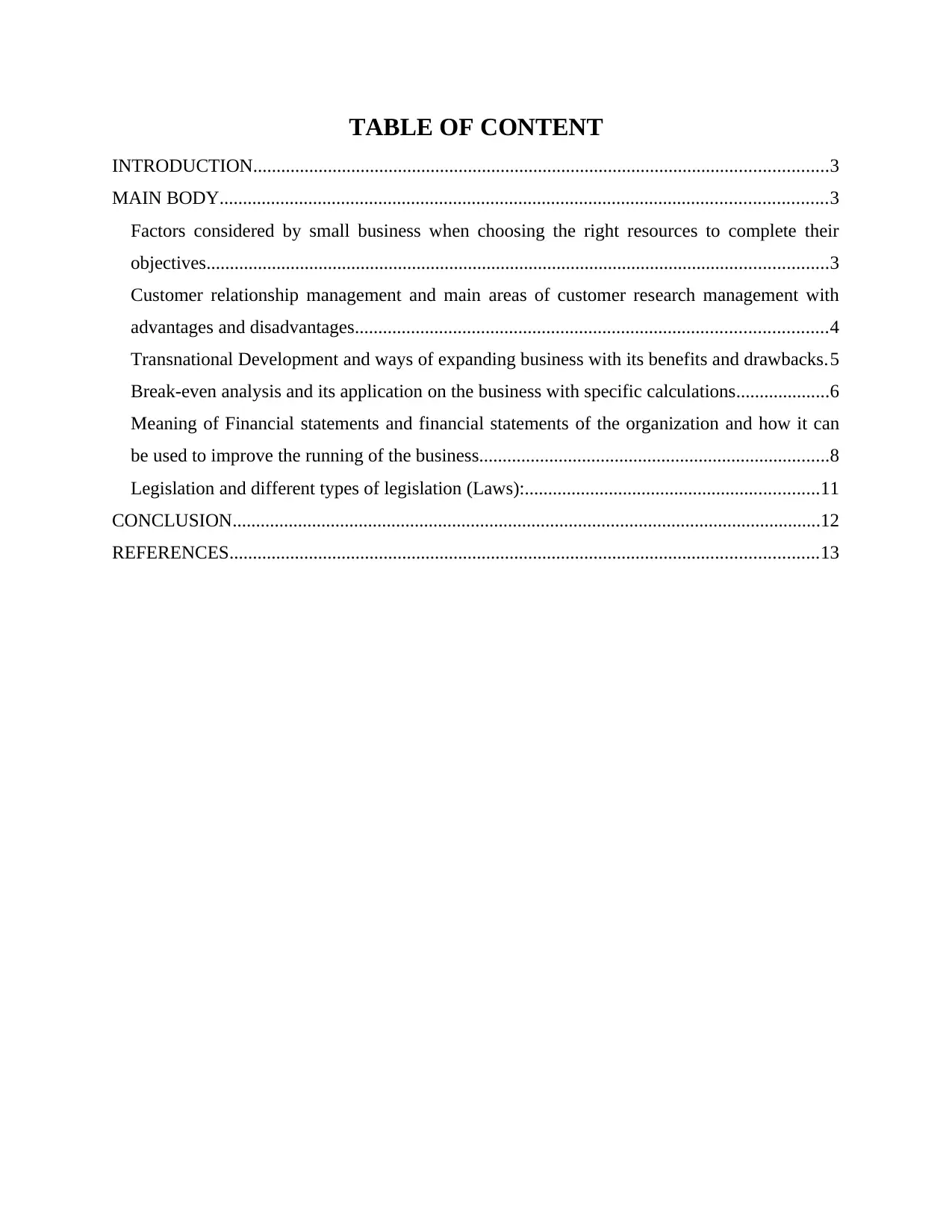
TABLE OF CONTENT
INTRODUCTION...........................................................................................................................3
MAIN BODY..................................................................................................................................3
Factors considered by small business when choosing the right resources to complete their
objectives.....................................................................................................................................3
Customer relationship management and main areas of customer research management with
advantages and disadvantages.....................................................................................................4
Transnational Development and ways of expanding business with its benefits and drawbacks.5
Break-even analysis and its application on the business with specific calculations....................6
Meaning of Financial statements and financial statements of the organization and how it can
be used to improve the running of the business...........................................................................8
Legislation and different types of legislation (Laws):...............................................................11
CONCLUSION..............................................................................................................................12
REFERENCES..............................................................................................................................13
INTRODUCTION...........................................................................................................................3
MAIN BODY..................................................................................................................................3
Factors considered by small business when choosing the right resources to complete their
objectives.....................................................................................................................................3
Customer relationship management and main areas of customer research management with
advantages and disadvantages.....................................................................................................4
Transnational Development and ways of expanding business with its benefits and drawbacks.5
Break-even analysis and its application on the business with specific calculations....................6
Meaning of Financial statements and financial statements of the organization and how it can
be used to improve the running of the business...........................................................................8
Legislation and different types of legislation (Laws):...............................................................11
CONCLUSION..............................................................................................................................12
REFERENCES..............................................................................................................................13
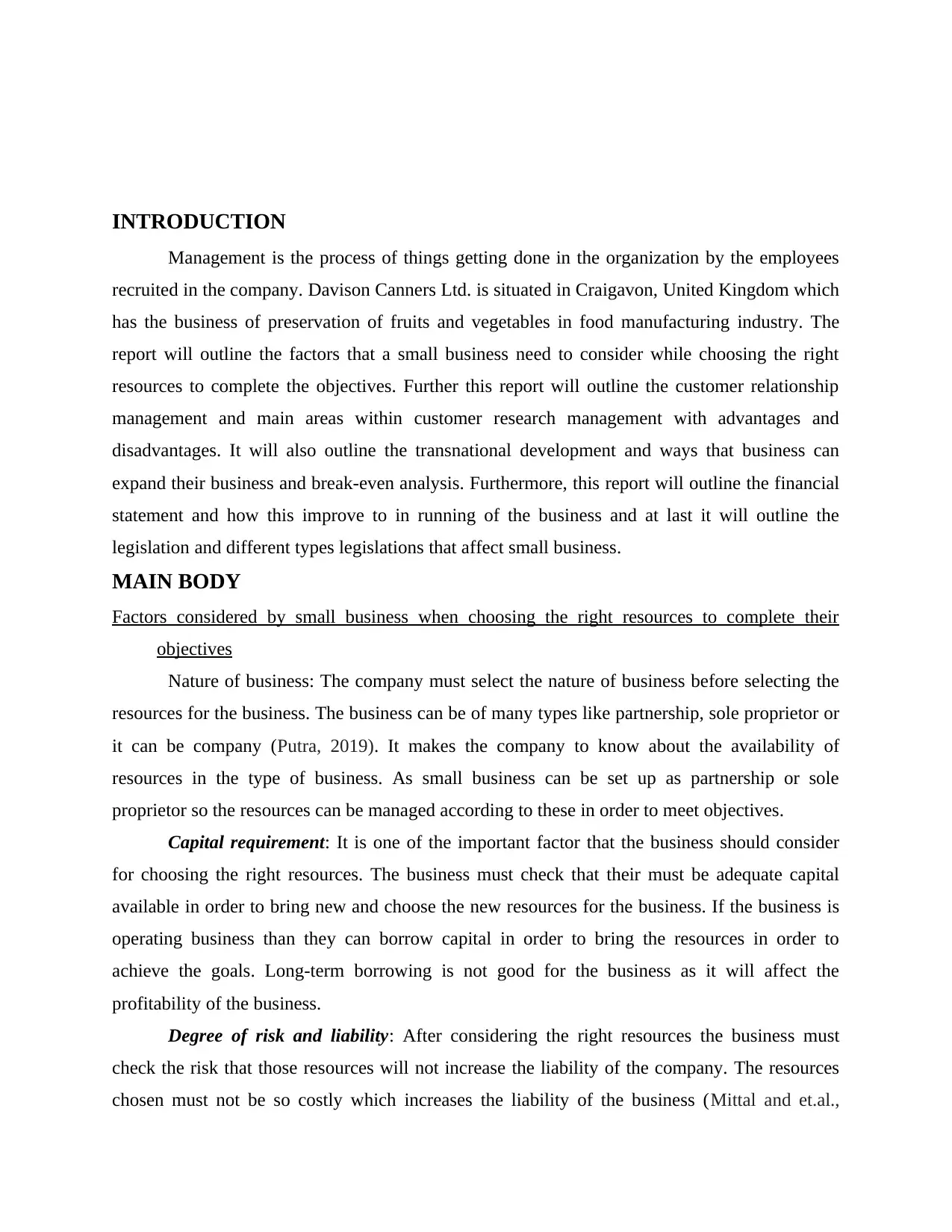
INTRODUCTION
Management is the process of things getting done in the organization by the employees
recruited in the company. Davison Canners Ltd. is situated in Craigavon, United Kingdom which
has the business of preservation of fruits and vegetables in food manufacturing industry. The
report will outline the factors that a small business need to consider while choosing the right
resources to complete the objectives. Further this report will outline the customer relationship
management and main areas within customer research management with advantages and
disadvantages. It will also outline the transnational development and ways that business can
expand their business and break-even analysis. Furthermore, this report will outline the financial
statement and how this improve to in running of the business and at last it will outline the
legislation and different types legislations that affect small business.
MAIN BODY
Factors considered by small business when choosing the right resources to complete their
objectives
Nature of business: The company must select the nature of business before selecting the
resources for the business. The business can be of many types like partnership, sole proprietor or
it can be company (Putra, 2019). It makes the company to know about the availability of
resources in the type of business. As small business can be set up as partnership or sole
proprietor so the resources can be managed according to these in order to meet objectives.
Capital requirement: It is one of the important factor that the business should consider
for choosing the right resources. The business must check that their must be adequate capital
available in order to bring new and choose the new resources for the business. If the business is
operating business than they can borrow capital in order to bring the resources in order to
achieve the goals. Long-term borrowing is not good for the business as it will affect the
profitability of the business.
Degree of risk and liability: After considering the right resources the business must
check the risk that those resources will not increase the liability of the company. The resources
chosen must not be so costly which increases the liability of the business (Mittal and et.al.,
Management is the process of things getting done in the organization by the employees
recruited in the company. Davison Canners Ltd. is situated in Craigavon, United Kingdom which
has the business of preservation of fruits and vegetables in food manufacturing industry. The
report will outline the factors that a small business need to consider while choosing the right
resources to complete the objectives. Further this report will outline the customer relationship
management and main areas within customer research management with advantages and
disadvantages. It will also outline the transnational development and ways that business can
expand their business and break-even analysis. Furthermore, this report will outline the financial
statement and how this improve to in running of the business and at last it will outline the
legislation and different types legislations that affect small business.
MAIN BODY
Factors considered by small business when choosing the right resources to complete their
objectives
Nature of business: The company must select the nature of business before selecting the
resources for the business. The business can be of many types like partnership, sole proprietor or
it can be company (Putra, 2019). It makes the company to know about the availability of
resources in the type of business. As small business can be set up as partnership or sole
proprietor so the resources can be managed according to these in order to meet objectives.
Capital requirement: It is one of the important factor that the business should consider
for choosing the right resources. The business must check that their must be adequate capital
available in order to bring new and choose the new resources for the business. If the business is
operating business than they can borrow capital in order to bring the resources in order to
achieve the goals. Long-term borrowing is not good for the business as it will affect the
profitability of the business.
Degree of risk and liability: After considering the right resources the business must
check the risk that those resources will not increase the liability of the company. The resources
chosen must not be so costly which increases the liability of the business (Mittal and et.al.,
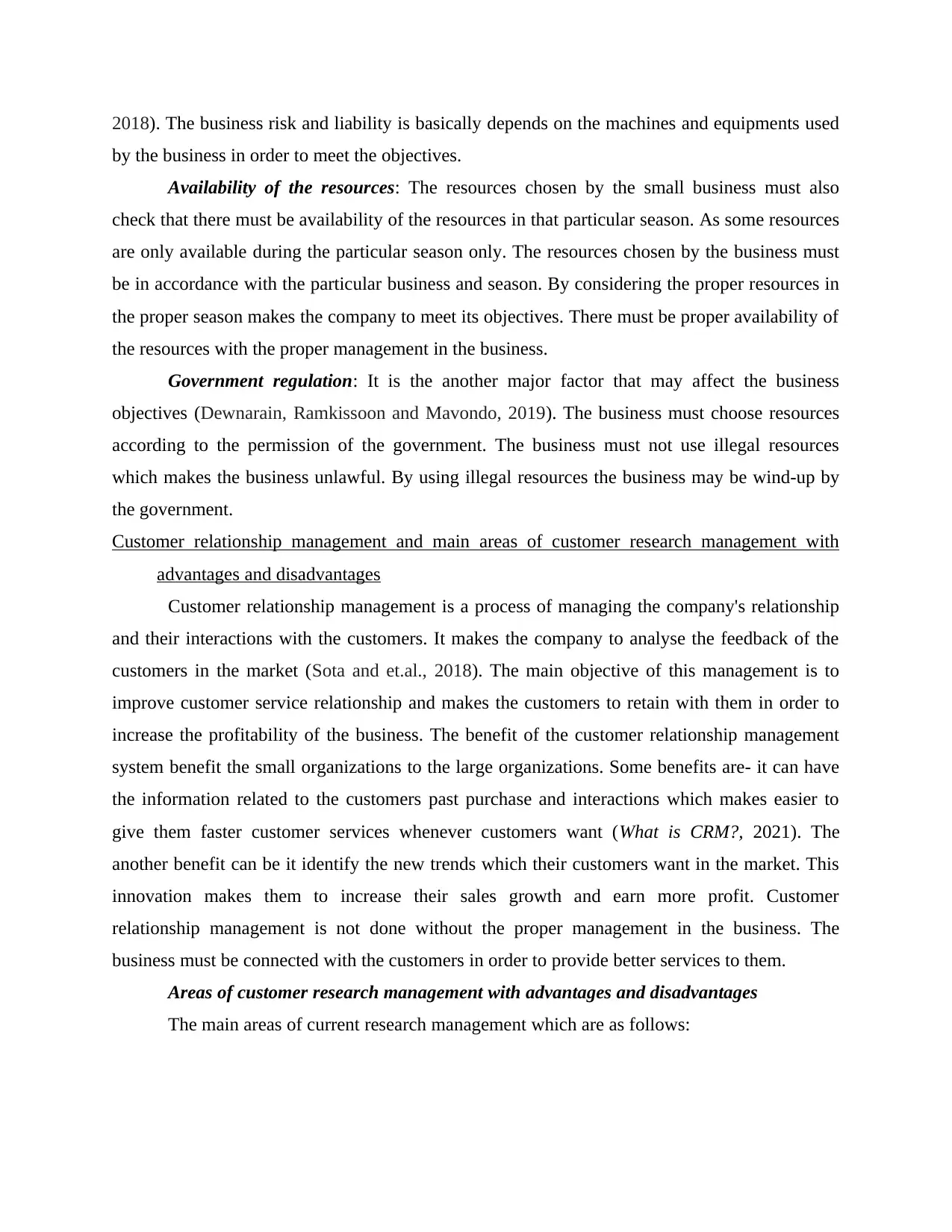
2018). The business risk and liability is basically depends on the machines and equipments used
by the business in order to meet the objectives.
Availability of the resources: The resources chosen by the small business must also
check that there must be availability of the resources in that particular season. As some resources
are only available during the particular season only. The resources chosen by the business must
be in accordance with the particular business and season. By considering the proper resources in
the proper season makes the company to meet its objectives. There must be proper availability of
the resources with the proper management in the business.
Government regulation: It is the another major factor that may affect the business
objectives (Dewnarain, Ramkissoon and Mavondo, 2019). The business must choose resources
according to the permission of the government. The business must not use illegal resources
which makes the business unlawful. By using illegal resources the business may be wind-up by
the government.
Customer relationship management and main areas of customer research management with
advantages and disadvantages
Customer relationship management is a process of managing the company's relationship
and their interactions with the customers. It makes the company to analyse the feedback of the
customers in the market (Sota and et.al., 2018). The main objective of this management is to
improve customer service relationship and makes the customers to retain with them in order to
increase the profitability of the business. The benefit of the customer relationship management
system benefit the small organizations to the large organizations. Some benefits are- it can have
the information related to the customers past purchase and interactions which makes easier to
give them faster customer services whenever customers want (What is CRM?, 2021). The
another benefit can be it identify the new trends which their customers want in the market. This
innovation makes them to increase their sales growth and earn more profit. Customer
relationship management is not done without the proper management in the business. The
business must be connected with the customers in order to provide better services to them.
Areas of customer research management with advantages and disadvantages
The main areas of current research management which are as follows:
by the business in order to meet the objectives.
Availability of the resources: The resources chosen by the small business must also
check that there must be availability of the resources in that particular season. As some resources
are only available during the particular season only. The resources chosen by the business must
be in accordance with the particular business and season. By considering the proper resources in
the proper season makes the company to meet its objectives. There must be proper availability of
the resources with the proper management in the business.
Government regulation: It is the another major factor that may affect the business
objectives (Dewnarain, Ramkissoon and Mavondo, 2019). The business must choose resources
according to the permission of the government. The business must not use illegal resources
which makes the business unlawful. By using illegal resources the business may be wind-up by
the government.
Customer relationship management and main areas of customer research management with
advantages and disadvantages
Customer relationship management is a process of managing the company's relationship
and their interactions with the customers. It makes the company to analyse the feedback of the
customers in the market (Sota and et.al., 2018). The main objective of this management is to
improve customer service relationship and makes the customers to retain with them in order to
increase the profitability of the business. The benefit of the customer relationship management
system benefit the small organizations to the large organizations. Some benefits are- it can have
the information related to the customers past purchase and interactions which makes easier to
give them faster customer services whenever customers want (What is CRM?, 2021). The
another benefit can be it identify the new trends which their customers want in the market. This
innovation makes them to increase their sales growth and earn more profit. Customer
relationship management is not done without the proper management in the business. The
business must be connected with the customers in order to provide better services to them.
Areas of customer research management with advantages and disadvantages
The main areas of current research management which are as follows:
Secure Best Marks with AI Grader
Need help grading? Try our AI Grader for instant feedback on your assignments.
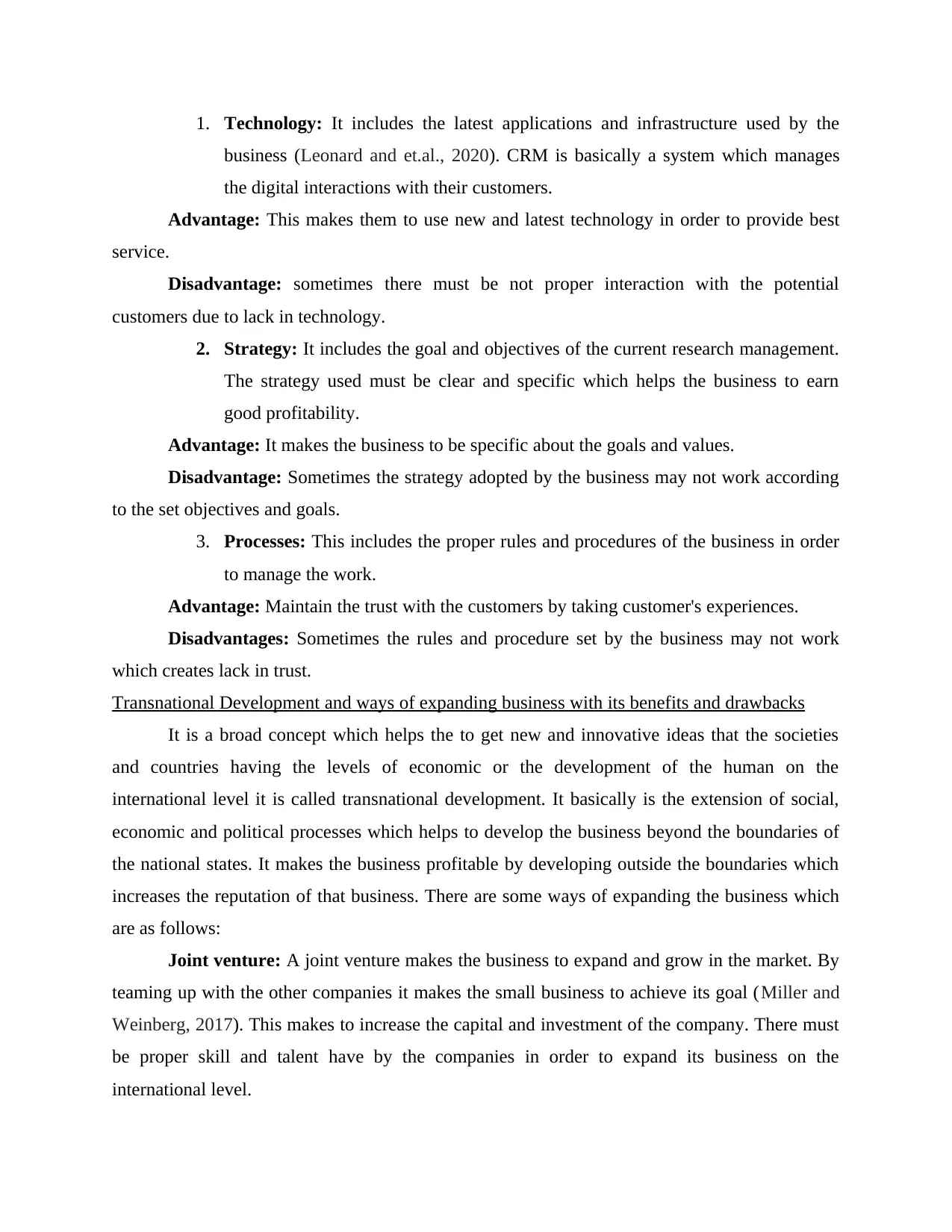
1. Technology: It includes the latest applications and infrastructure used by the
business (Leonard and et.al., 2020). CRM is basically a system which manages
the digital interactions with their customers.
Advantage: This makes them to use new and latest technology in order to provide best
service.
Disadvantage: sometimes there must be not proper interaction with the potential
customers due to lack in technology.
2. Strategy: It includes the goal and objectives of the current research management.
The strategy used must be clear and specific which helps the business to earn
good profitability.
Advantage: It makes the business to be specific about the goals and values.
Disadvantage: Sometimes the strategy adopted by the business may not work according
to the set objectives and goals.
3. Processes: This includes the proper rules and procedures of the business in order
to manage the work.
Advantage: Maintain the trust with the customers by taking customer's experiences.
Disadvantages: Sometimes the rules and procedure set by the business may not work
which creates lack in trust.
Transnational Development and ways of expanding business with its benefits and drawbacks
It is a broad concept which helps the to get new and innovative ideas that the societies
and countries having the levels of economic or the development of the human on the
international level it is called transnational development. It basically is the extension of social,
economic and political processes which helps to develop the business beyond the boundaries of
the national states. It makes the business profitable by developing outside the boundaries which
increases the reputation of that business. There are some ways of expanding the business which
are as follows:
Joint venture: A joint venture makes the business to expand and grow in the market. By
teaming up with the other companies it makes the small business to achieve its goal (Miller and
Weinberg, 2017). This makes to increase the capital and investment of the company. There must
be proper skill and talent have by the companies in order to expand its business on the
international level.
business (Leonard and et.al., 2020). CRM is basically a system which manages
the digital interactions with their customers.
Advantage: This makes them to use new and latest technology in order to provide best
service.
Disadvantage: sometimes there must be not proper interaction with the potential
customers due to lack in technology.
2. Strategy: It includes the goal and objectives of the current research management.
The strategy used must be clear and specific which helps the business to earn
good profitability.
Advantage: It makes the business to be specific about the goals and values.
Disadvantage: Sometimes the strategy adopted by the business may not work according
to the set objectives and goals.
3. Processes: This includes the proper rules and procedures of the business in order
to manage the work.
Advantage: Maintain the trust with the customers by taking customer's experiences.
Disadvantages: Sometimes the rules and procedure set by the business may not work
which creates lack in trust.
Transnational Development and ways of expanding business with its benefits and drawbacks
It is a broad concept which helps the to get new and innovative ideas that the societies
and countries having the levels of economic or the development of the human on the
international level it is called transnational development. It basically is the extension of social,
economic and political processes which helps to develop the business beyond the boundaries of
the national states. It makes the business profitable by developing outside the boundaries which
increases the reputation of that business. There are some ways of expanding the business which
are as follows:
Joint venture: A joint venture makes the business to expand and grow in the market. By
teaming up with the other companies it makes the small business to achieve its goal (Miller and
Weinberg, 2017). This makes to increase the capital and investment of the company. There must
be proper skill and talent have by the companies in order to expand its business on the
international level.
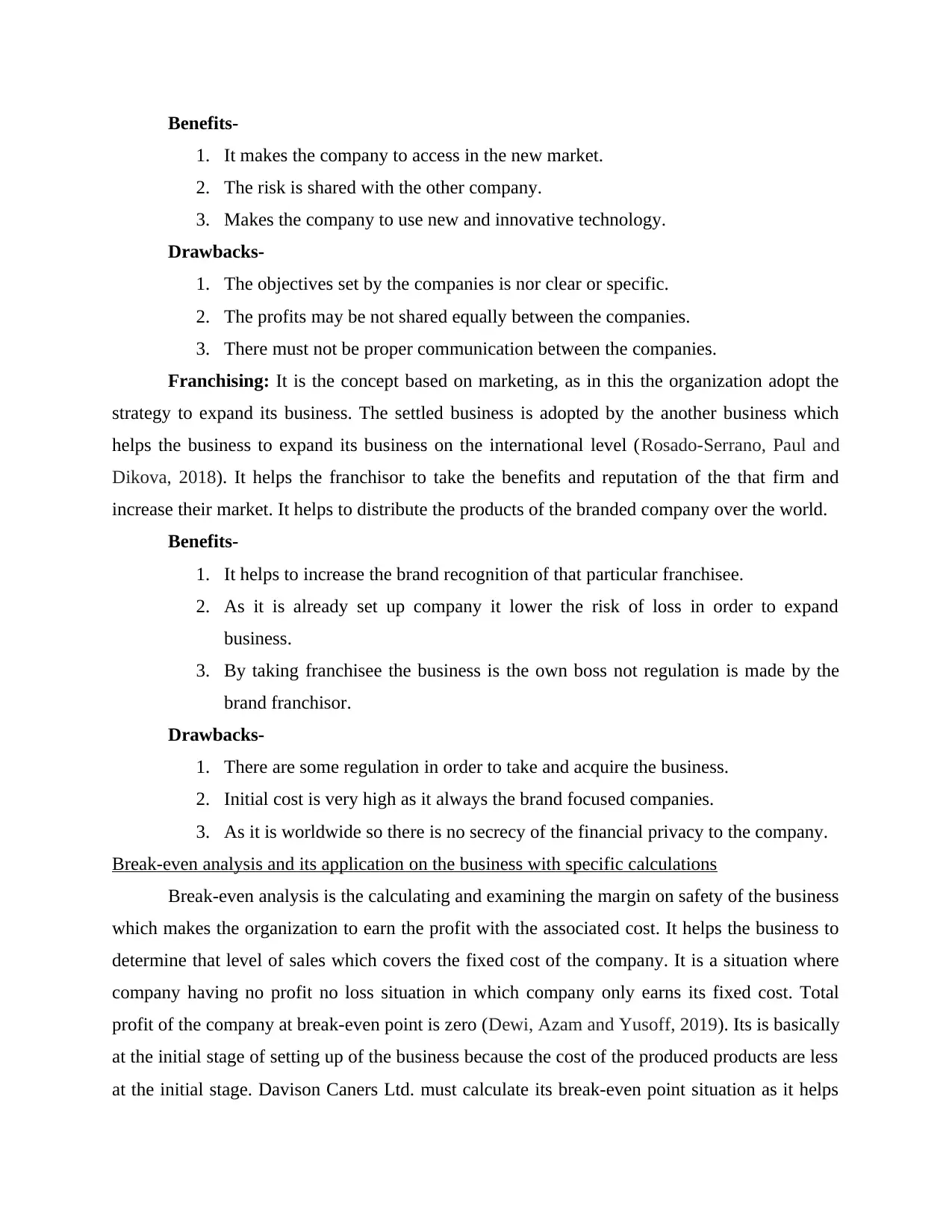
Benefits-
1. It makes the company to access in the new market.
2. The risk is shared with the other company.
3. Makes the company to use new and innovative technology.
Drawbacks-
1. The objectives set by the companies is nor clear or specific.
2. The profits may be not shared equally between the companies.
3. There must not be proper communication between the companies.
Franchising: It is the concept based on marketing, as in this the organization adopt the
strategy to expand its business. The settled business is adopted by the another business which
helps the business to expand its business on the international level (Rosado-Serrano, Paul and
Dikova, 2018). It helps the franchisor to take the benefits and reputation of the that firm and
increase their market. It helps to distribute the products of the branded company over the world.
Benefits-
1. It helps to increase the brand recognition of that particular franchisee.
2. As it is already set up company it lower the risk of loss in order to expand
business.
3. By taking franchisee the business is the own boss not regulation is made by the
brand franchisor.
Drawbacks-
1. There are some regulation in order to take and acquire the business.
2. Initial cost is very high as it always the brand focused companies.
3. As it is worldwide so there is no secrecy of the financial privacy to the company.
Break-even analysis and its application on the business with specific calculations
Break-even analysis is the calculating and examining the margin on safety of the business
which makes the organization to earn the profit with the associated cost. It helps the business to
determine that level of sales which covers the fixed cost of the company. It is a situation where
company having no profit no loss situation in which company only earns its fixed cost. Total
profit of the company at break-even point is zero (Dewi, Azam and Yusoff, 2019). Its is basically
at the initial stage of setting up of the business because the cost of the produced products are less
at the initial stage. Davison Caners Ltd. must calculate its break-even point situation as it helps
1. It makes the company to access in the new market.
2. The risk is shared with the other company.
3. Makes the company to use new and innovative technology.
Drawbacks-
1. The objectives set by the companies is nor clear or specific.
2. The profits may be not shared equally between the companies.
3. There must not be proper communication between the companies.
Franchising: It is the concept based on marketing, as in this the organization adopt the
strategy to expand its business. The settled business is adopted by the another business which
helps the business to expand its business on the international level (Rosado-Serrano, Paul and
Dikova, 2018). It helps the franchisor to take the benefits and reputation of the that firm and
increase their market. It helps to distribute the products of the branded company over the world.
Benefits-
1. It helps to increase the brand recognition of that particular franchisee.
2. As it is already set up company it lower the risk of loss in order to expand
business.
3. By taking franchisee the business is the own boss not regulation is made by the
brand franchisor.
Drawbacks-
1. There are some regulation in order to take and acquire the business.
2. Initial cost is very high as it always the brand focused companies.
3. As it is worldwide so there is no secrecy of the financial privacy to the company.
Break-even analysis and its application on the business with specific calculations
Break-even analysis is the calculating and examining the margin on safety of the business
which makes the organization to earn the profit with the associated cost. It helps the business to
determine that level of sales which covers the fixed cost of the company. It is a situation where
company having no profit no loss situation in which company only earns its fixed cost. Total
profit of the company at break-even point is zero (Dewi, Azam and Yusoff, 2019). Its is basically
at the initial stage of setting up of the business because the cost of the produced products are less
at the initial stage. Davison Caners Ltd. must calculate its break-even point situation as it helps
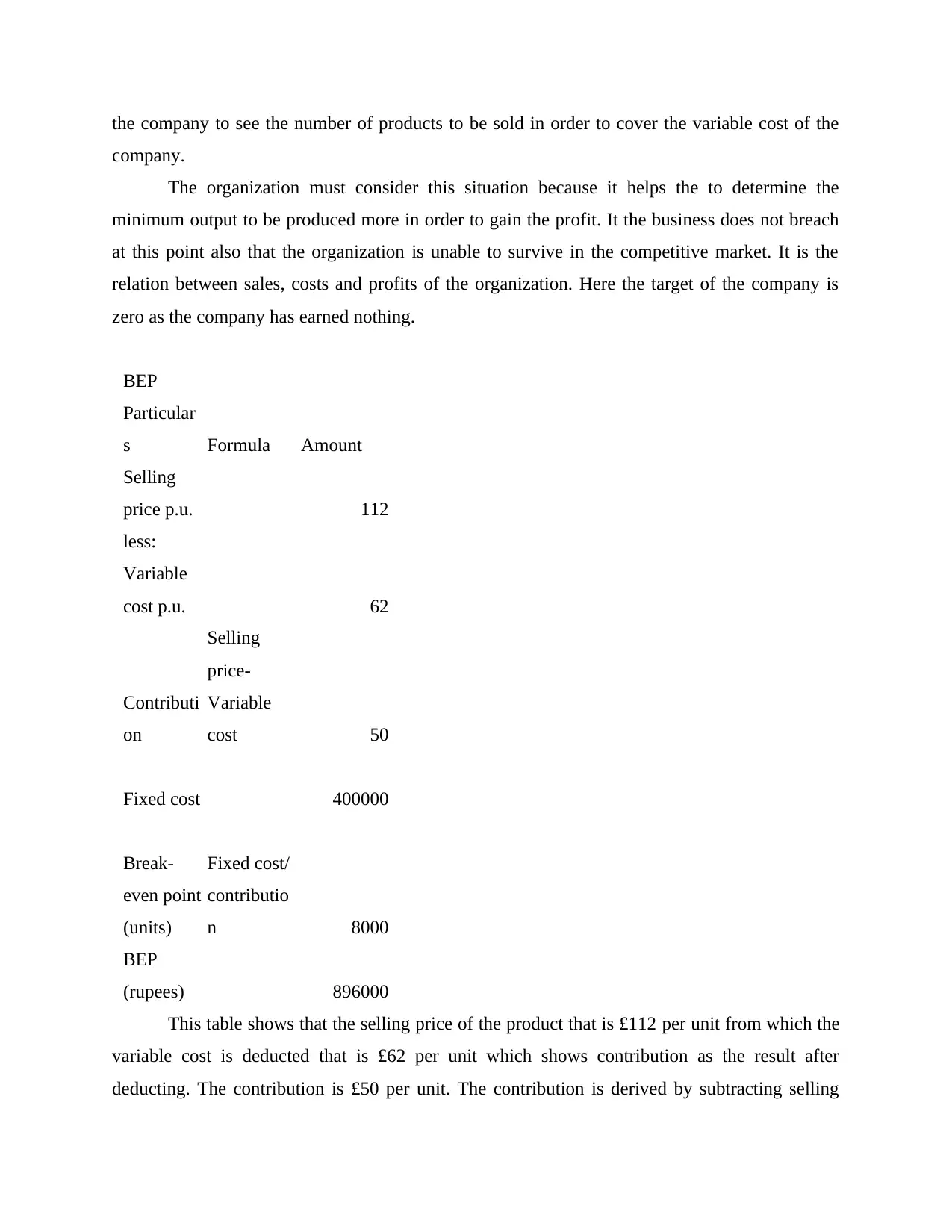
the company to see the number of products to be sold in order to cover the variable cost of the
company.
The organization must consider this situation because it helps the to determine the
minimum output to be produced more in order to gain the profit. It the business does not breach
at this point also that the organization is unable to survive in the competitive market. It is the
relation between sales, costs and profits of the organization. Here the target of the company is
zero as the company has earned nothing.
BEP
Particular
s Formula Amount
Selling
price p.u. 112
less:
Variable
cost p.u. 62
Contributi
on
Selling
price-
Variable
cost 50
Fixed cost 400000
Break-
even point
(units)
Fixed cost/
contributio
n 8000
BEP
(rupees) 896000
This table shows that the selling price of the product that is £112 per unit from which the
variable cost is deducted that is £62 per unit which shows contribution as the result after
deducting. The contribution is £50 per unit. The contribution is derived by subtracting selling
company.
The organization must consider this situation because it helps the to determine the
minimum output to be produced more in order to gain the profit. It the business does not breach
at this point also that the organization is unable to survive in the competitive market. It is the
relation between sales, costs and profits of the organization. Here the target of the company is
zero as the company has earned nothing.
BEP
Particular
s Formula Amount
Selling
price p.u. 112
less:
Variable
cost p.u. 62
Contributi
on
Selling
price-
Variable
cost 50
Fixed cost 400000
Break-
even point
(units)
Fixed cost/
contributio
n 8000
BEP
(rupees) 896000
This table shows that the selling price of the product that is £112 per unit from which the
variable cost is deducted that is £62 per unit which shows contribution as the result after
deducting. The contribution is £50 per unit. The contribution is derived by subtracting selling
Paraphrase This Document
Need a fresh take? Get an instant paraphrase of this document with our AI Paraphraser
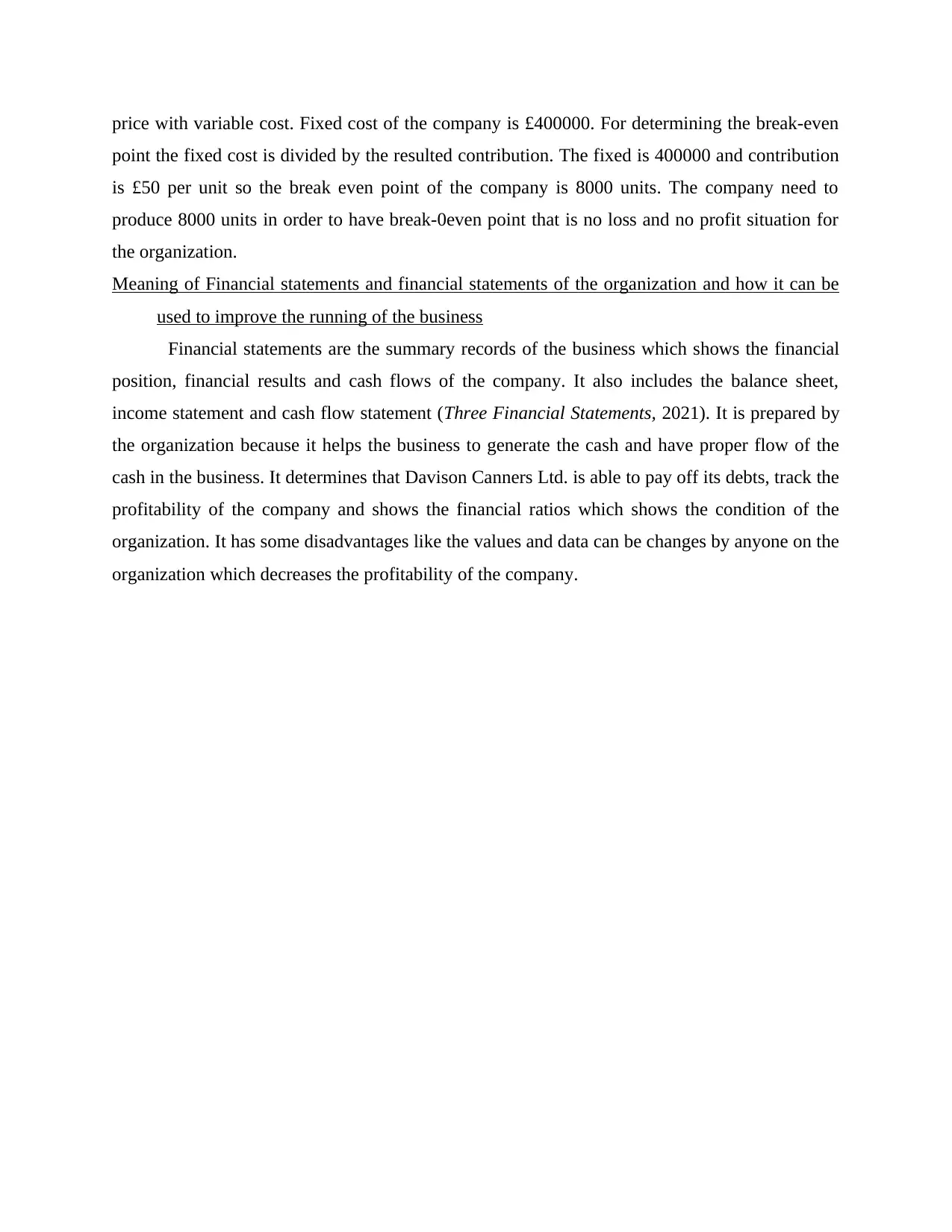
price with variable cost. Fixed cost of the company is £400000. For determining the break-even
point the fixed cost is divided by the resulted contribution. The fixed is 400000 and contribution
is £50 per unit so the break even point of the company is 8000 units. The company need to
produce 8000 units in order to have break-0even point that is no loss and no profit situation for
the organization.
Meaning of Financial statements and financial statements of the organization and how it can be
used to improve the running of the business
Financial statements are the summary records of the business which shows the financial
position, financial results and cash flows of the company. It also includes the balance sheet,
income statement and cash flow statement (Three Financial Statements, 2021). It is prepared by
the organization because it helps the business to generate the cash and have proper flow of the
cash in the business. It determines that Davison Canners Ltd. is able to pay off its debts, track the
profitability of the company and shows the financial ratios which shows the condition of the
organization. It has some disadvantages like the values and data can be changes by anyone on the
organization which decreases the profitability of the company.
point the fixed cost is divided by the resulted contribution. The fixed is 400000 and contribution
is £50 per unit so the break even point of the company is 8000 units. The company need to
produce 8000 units in order to have break-0even point that is no loss and no profit situation for
the organization.
Meaning of Financial statements and financial statements of the organization and how it can be
used to improve the running of the business
Financial statements are the summary records of the business which shows the financial
position, financial results and cash flows of the company. It also includes the balance sheet,
income statement and cash flow statement (Three Financial Statements, 2021). It is prepared by
the organization because it helps the business to generate the cash and have proper flow of the
cash in the business. It determines that Davison Canners Ltd. is able to pay off its debts, track the
profitability of the company and shows the financial ratios which shows the condition of the
organization. It has some disadvantages like the values and data can be changes by anyone on the
organization which decreases the profitability of the company.
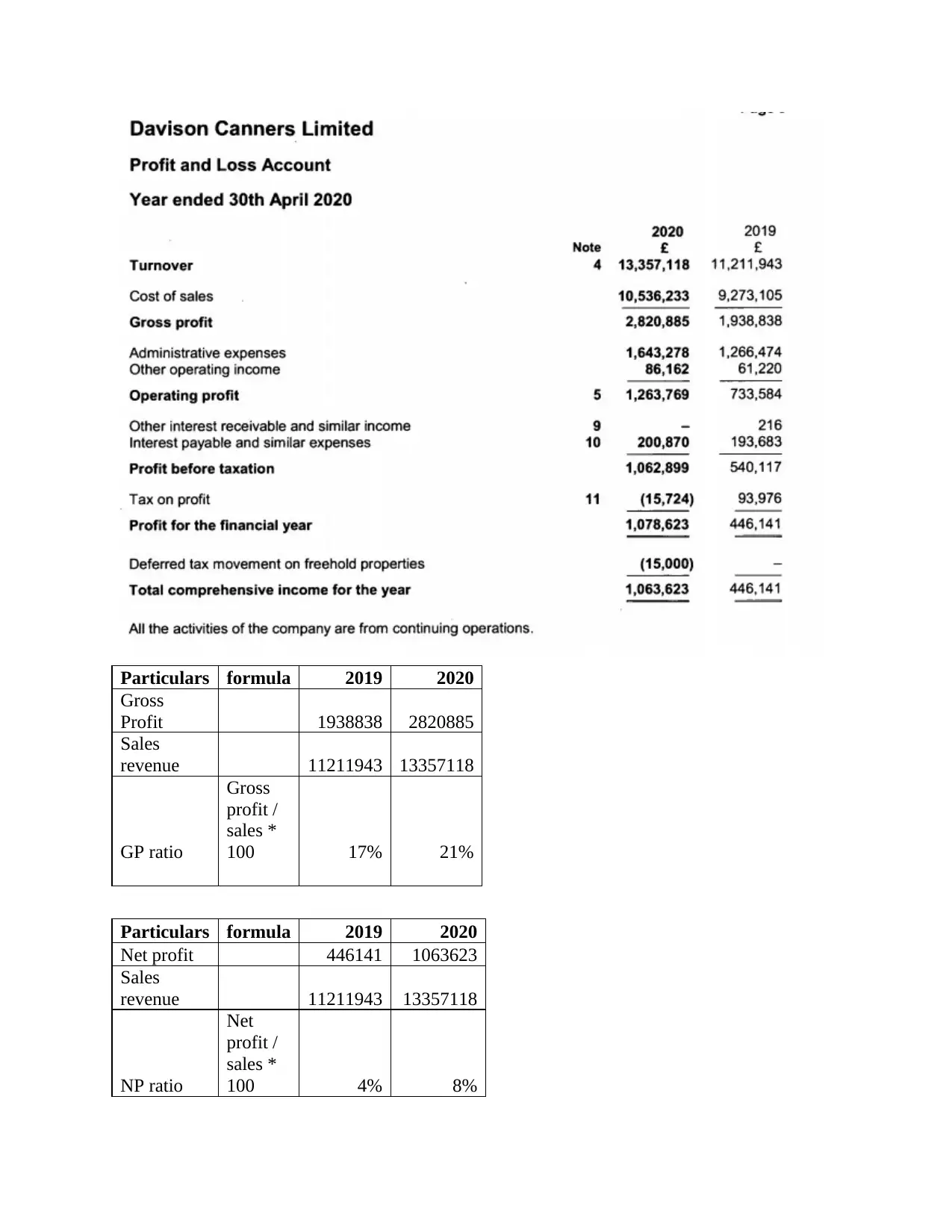
Particulars formula 2019 2020
Gross
Profit 1938838 2820885
Sales
revenue 11211943 13357118
GP ratio
Gross
profit /
sales *
100 17% 21%
Particulars formula 2019 2020
Net profit 446141 1063623
Sales
revenue 11211943 13357118
NP ratio
Net
profit /
sales *
100 4% 8%
Gross
Profit 1938838 2820885
Sales
revenue 11211943 13357118
GP ratio
Gross
profit /
sales *
100 17% 21%
Particulars formula 2019 2020
Net profit 446141 1063623
Sales
revenue 11211943 13357118
NP ratio
Net
profit /
sales *
100 4% 8%
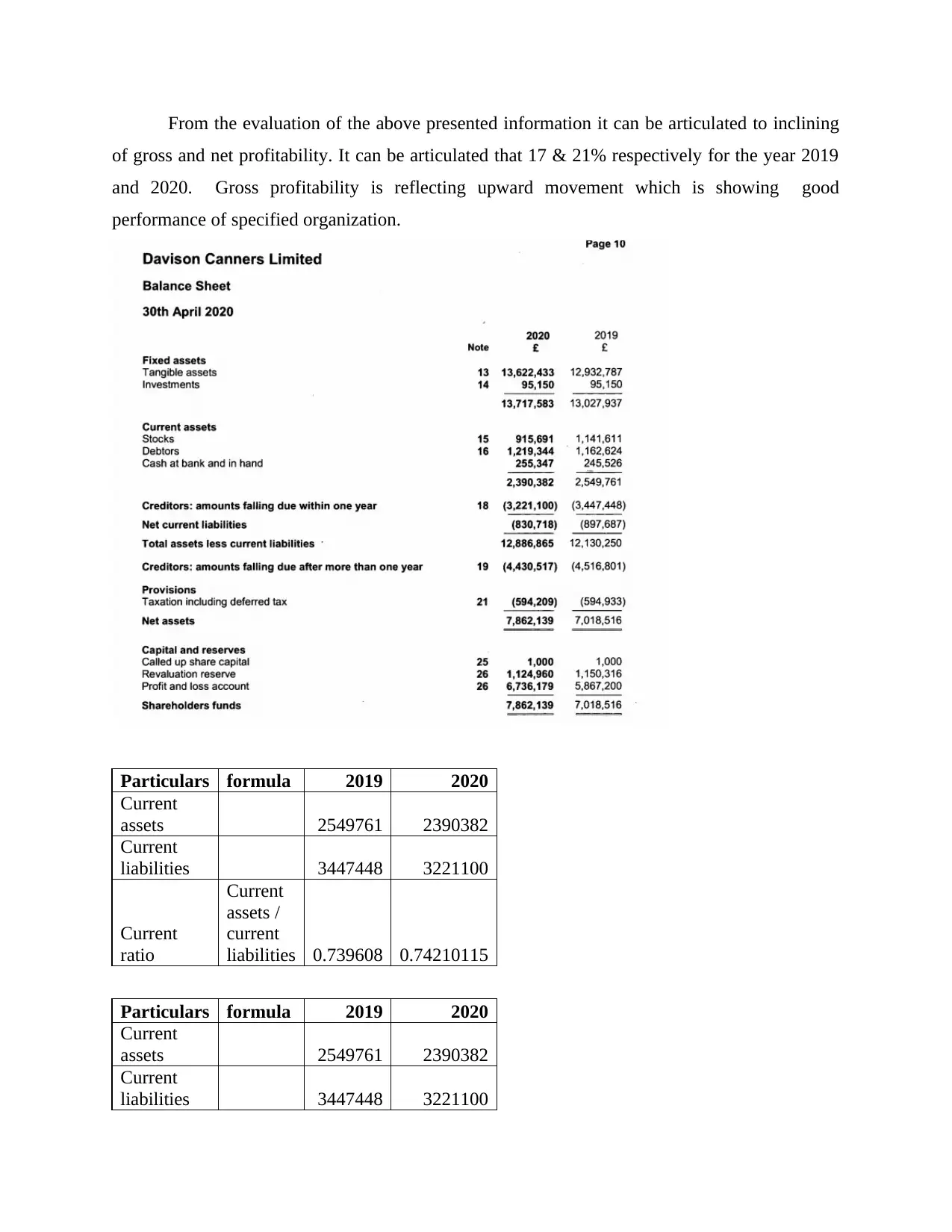
From the evaluation of the above presented information it can be articulated to inclining
of gross and net profitability. It can be articulated that 17 & 21% respectively for the year 2019
and 2020. Gross profitability is reflecting upward movement which is showing good
performance of specified organization.
Particulars formula 2019 2020
Current
assets 2549761 2390382
Current
liabilities 3447448 3221100
Current
ratio
Current
assets /
current
liabilities 0.739608 0.74210115
Particulars formula 2019 2020
Current
assets 2549761 2390382
Current
liabilities 3447448 3221100
of gross and net profitability. It can be articulated that 17 & 21% respectively for the year 2019
and 2020. Gross profitability is reflecting upward movement which is showing good
performance of specified organization.
Particulars formula 2019 2020
Current
assets 2549761 2390382
Current
liabilities 3447448 3221100
Current
ratio
Current
assets /
current
liabilities 0.739608 0.74210115
Particulars formula 2019 2020
Current
assets 2549761 2390382
Current
liabilities 3447448 3221100
Secure Best Marks with AI Grader
Need help grading? Try our AI Grader for instant feedback on your assignments.
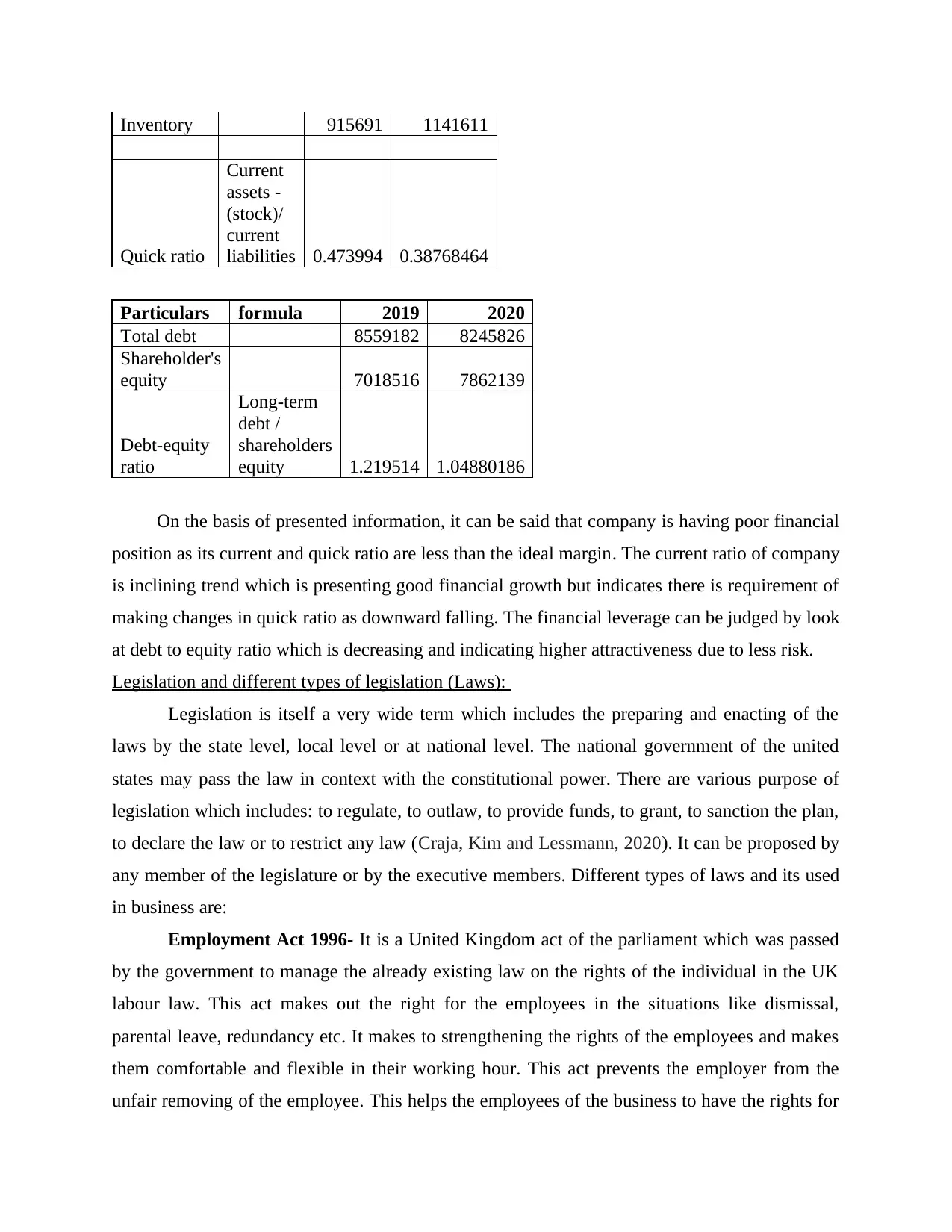
Inventory 915691 1141611
Quick ratio
Current
assets -
(stock)/
current
liabilities 0.473994 0.38768464
Particulars formula 2019 2020
Total debt 8559182 8245826
Shareholder's
equity 7018516 7862139
Debt-equity
ratio
Long-term
debt /
shareholders
equity 1.219514 1.04880186
On the basis of presented information, it can be said that company is having poor financial
position as its current and quick ratio are less than the ideal margin. The current ratio of company
is inclining trend which is presenting good financial growth but indicates there is requirement of
making changes in quick ratio as downward falling. The financial leverage can be judged by look
at debt to equity ratio which is decreasing and indicating higher attractiveness due to less risk.
Legislation and different types of legislation (Laws):
Legislation is itself a very wide term which includes the preparing and enacting of the
laws by the state level, local level or at national level. The national government of the united
states may pass the law in context with the constitutional power. There are various purpose of
legislation which includes: to regulate, to outlaw, to provide funds, to grant, to sanction the plan,
to declare the law or to restrict any law (Craja, Kim and Lessmann, 2020). It can be proposed by
any member of the legislature or by the executive members. Different types of laws and its used
in business are:
Employment Act 1996- It is a United Kingdom act of the parliament which was passed
by the government to manage the already existing law on the rights of the individual in the UK
labour law. This act makes out the right for the employees in the situations like dismissal,
parental leave, redundancy etc. It makes to strengthening the rights of the employees and makes
them comfortable and flexible in their working hour. This act prevents the employer from the
unfair removing of the employee. This helps the employees of the business to have the rights for
Quick ratio
Current
assets -
(stock)/
current
liabilities 0.473994 0.38768464
Particulars formula 2019 2020
Total debt 8559182 8245826
Shareholder's
equity 7018516 7862139
Debt-equity
ratio
Long-term
debt /
shareholders
equity 1.219514 1.04880186
On the basis of presented information, it can be said that company is having poor financial
position as its current and quick ratio are less than the ideal margin. The current ratio of company
is inclining trend which is presenting good financial growth but indicates there is requirement of
making changes in quick ratio as downward falling. The financial leverage can be judged by look
at debt to equity ratio which is decreasing and indicating higher attractiveness due to less risk.
Legislation and different types of legislation (Laws):
Legislation is itself a very wide term which includes the preparing and enacting of the
laws by the state level, local level or at national level. The national government of the united
states may pass the law in context with the constitutional power. There are various purpose of
legislation which includes: to regulate, to outlaw, to provide funds, to grant, to sanction the plan,
to declare the law or to restrict any law (Craja, Kim and Lessmann, 2020). It can be proposed by
any member of the legislature or by the executive members. Different types of laws and its used
in business are:
Employment Act 1996- It is a United Kingdom act of the parliament which was passed
by the government to manage the already existing law on the rights of the individual in the UK
labour law. This act makes out the right for the employees in the situations like dismissal,
parental leave, redundancy etc. It makes to strengthening the rights of the employees and makes
them comfortable and flexible in their working hour. This act prevents the employer from the
unfair removing of the employee. This helps the employees of the business to have the rights for
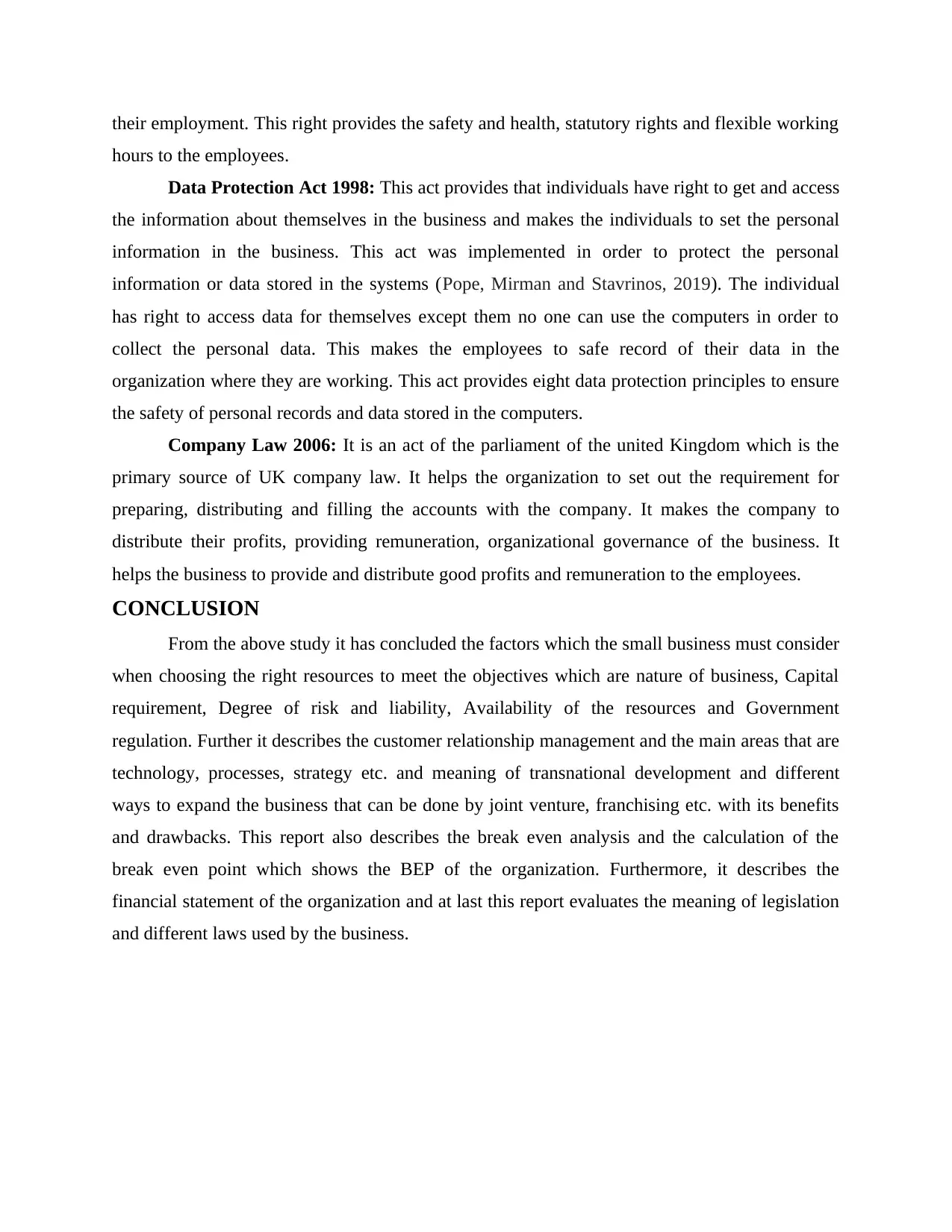
their employment. This right provides the safety and health, statutory rights and flexible working
hours to the employees.
Data Protection Act 1998: This act provides that individuals have right to get and access
the information about themselves in the business and makes the individuals to set the personal
information in the business. This act was implemented in order to protect the personal
information or data stored in the systems (Pope, Mirman and Stavrinos, 2019). The individual
has right to access data for themselves except them no one can use the computers in order to
collect the personal data. This makes the employees to safe record of their data in the
organization where they are working. This act provides eight data protection principles to ensure
the safety of personal records and data stored in the computers.
Company Law 2006: It is an act of the parliament of the united Kingdom which is the
primary source of UK company law. It helps the organization to set out the requirement for
preparing, distributing and filling the accounts with the company. It makes the company to
distribute their profits, providing remuneration, organizational governance of the business. It
helps the business to provide and distribute good profits and remuneration to the employees.
CONCLUSION
From the above study it has concluded the factors which the small business must consider
when choosing the right resources to meet the objectives which are nature of business, Capital
requirement, Degree of risk and liability, Availability of the resources and Government
regulation. Further it describes the customer relationship management and the main areas that are
technology, processes, strategy etc. and meaning of transnational development and different
ways to expand the business that can be done by joint venture, franchising etc. with its benefits
and drawbacks. This report also describes the break even analysis and the calculation of the
break even point which shows the BEP of the organization. Furthermore, it describes the
financial statement of the organization and at last this report evaluates the meaning of legislation
and different laws used by the business.
hours to the employees.
Data Protection Act 1998: This act provides that individuals have right to get and access
the information about themselves in the business and makes the individuals to set the personal
information in the business. This act was implemented in order to protect the personal
information or data stored in the systems (Pope, Mirman and Stavrinos, 2019). The individual
has right to access data for themselves except them no one can use the computers in order to
collect the personal data. This makes the employees to safe record of their data in the
organization where they are working. This act provides eight data protection principles to ensure
the safety of personal records and data stored in the computers.
Company Law 2006: It is an act of the parliament of the united Kingdom which is the
primary source of UK company law. It helps the organization to set out the requirement for
preparing, distributing and filling the accounts with the company. It makes the company to
distribute their profits, providing remuneration, organizational governance of the business. It
helps the business to provide and distribute good profits and remuneration to the employees.
CONCLUSION
From the above study it has concluded the factors which the small business must consider
when choosing the right resources to meet the objectives which are nature of business, Capital
requirement, Degree of risk and liability, Availability of the resources and Government
regulation. Further it describes the customer relationship management and the main areas that are
technology, processes, strategy etc. and meaning of transnational development and different
ways to expand the business that can be done by joint venture, franchising etc. with its benefits
and drawbacks. This report also describes the break even analysis and the calculation of the
break even point which shows the BEP of the organization. Furthermore, it describes the
financial statement of the organization and at last this report evaluates the meaning of legislation
and different laws used by the business.
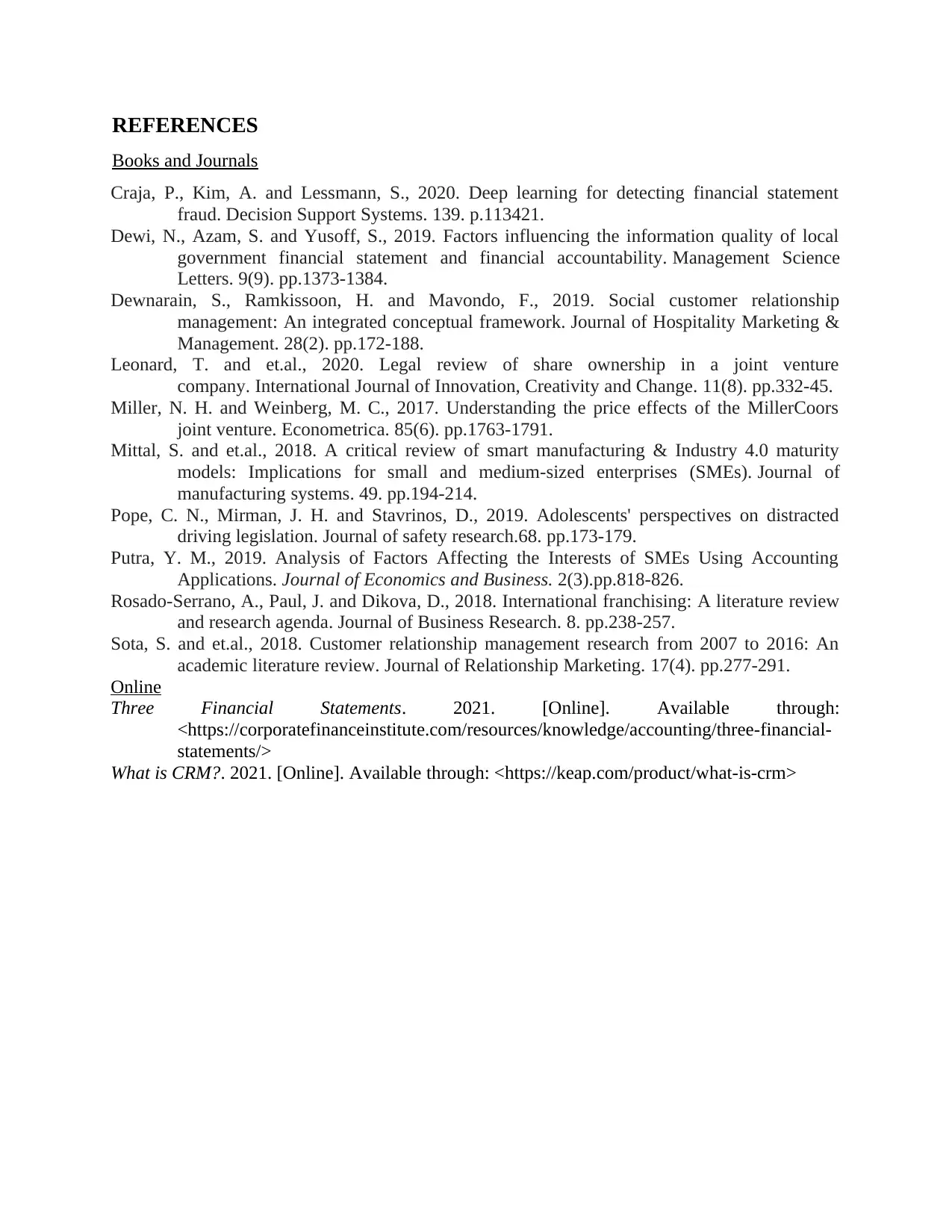
REFERENCES
Books and Journals
Craja, P., Kim, A. and Lessmann, S., 2020. Deep learning for detecting financial statement
fraud. Decision Support Systems. 139. p.113421.
Dewi, N., Azam, S. and Yusoff, S., 2019. Factors influencing the information quality of local
government financial statement and financial accountability. Management Science
Letters. 9(9). pp.1373-1384.
Dewnarain, S., Ramkissoon, H. and Mavondo, F., 2019. Social customer relationship
management: An integrated conceptual framework. Journal of Hospitality Marketing &
Management. 28(2). pp.172-188.
Leonard, T. and et.al., 2020. Legal review of share ownership in a joint venture
company. International Journal of Innovation, Creativity and Change. 11(8). pp.332-45.
Miller, N. H. and Weinberg, M. C., 2017. Understanding the price effects of the MillerCoors
joint venture. Econometrica. 85(6). pp.1763-1791.
Mittal, S. and et.al., 2018. A critical review of smart manufacturing & Industry 4.0 maturity
models: Implications for small and medium-sized enterprises (SMEs). Journal of
manufacturing systems. 49. pp.194-214.
Pope, C. N., Mirman, J. H. and Stavrinos, D., 2019. Adolescents' perspectives on distracted
driving legislation. Journal of safety research.68. pp.173-179.
Putra, Y. M., 2019. Analysis of Factors Affecting the Interests of SMEs Using Accounting
Applications. Journal of Economics and Business. 2(3).pp.818-826.
Rosado-Serrano, A., Paul, J. and Dikova, D., 2018. International franchising: A literature review
and research agenda. Journal of Business Research. 8. pp.238-257.
Sota, S. and et.al., 2018. Customer relationship management research from 2007 to 2016: An
academic literature review. Journal of Relationship Marketing. 17(4). pp.277-291.
Online
Three Financial Statements. 2021. [Online]. Available through:
<https://corporatefinanceinstitute.com/resources/knowledge/accounting/three-financial-
statements/>
What is CRM?. 2021. [Online]. Available through: <https://keap.com/product/what-is-crm>
Books and Journals
Craja, P., Kim, A. and Lessmann, S., 2020. Deep learning for detecting financial statement
fraud. Decision Support Systems. 139. p.113421.
Dewi, N., Azam, S. and Yusoff, S., 2019. Factors influencing the information quality of local
government financial statement and financial accountability. Management Science
Letters. 9(9). pp.1373-1384.
Dewnarain, S., Ramkissoon, H. and Mavondo, F., 2019. Social customer relationship
management: An integrated conceptual framework. Journal of Hospitality Marketing &
Management. 28(2). pp.172-188.
Leonard, T. and et.al., 2020. Legal review of share ownership in a joint venture
company. International Journal of Innovation, Creativity and Change. 11(8). pp.332-45.
Miller, N. H. and Weinberg, M. C., 2017. Understanding the price effects of the MillerCoors
joint venture. Econometrica. 85(6). pp.1763-1791.
Mittal, S. and et.al., 2018. A critical review of smart manufacturing & Industry 4.0 maturity
models: Implications for small and medium-sized enterprises (SMEs). Journal of
manufacturing systems. 49. pp.194-214.
Pope, C. N., Mirman, J. H. and Stavrinos, D., 2019. Adolescents' perspectives on distracted
driving legislation. Journal of safety research.68. pp.173-179.
Putra, Y. M., 2019. Analysis of Factors Affecting the Interests of SMEs Using Accounting
Applications. Journal of Economics and Business. 2(3).pp.818-826.
Rosado-Serrano, A., Paul, J. and Dikova, D., 2018. International franchising: A literature review
and research agenda. Journal of Business Research. 8. pp.238-257.
Sota, S. and et.al., 2018. Customer relationship management research from 2007 to 2016: An
academic literature review. Journal of Relationship Marketing. 17(4). pp.277-291.
Online
Three Financial Statements. 2021. [Online]. Available through:
<https://corporatefinanceinstitute.com/resources/knowledge/accounting/three-financial-
statements/>
What is CRM?. 2021. [Online]. Available through: <https://keap.com/product/what-is-crm>
Paraphrase This Document
Need a fresh take? Get an instant paraphrase of this document with our AI Paraphraser


1 out of 15
Related Documents
Your All-in-One AI-Powered Toolkit for Academic Success.
+13062052269
info@desklib.com
Available 24*7 on WhatsApp / Email
![[object Object]](/_next/static/media/star-bottom.7253800d.svg)
Unlock your academic potential
© 2024 | Zucol Services PVT LTD | All rights reserved.





